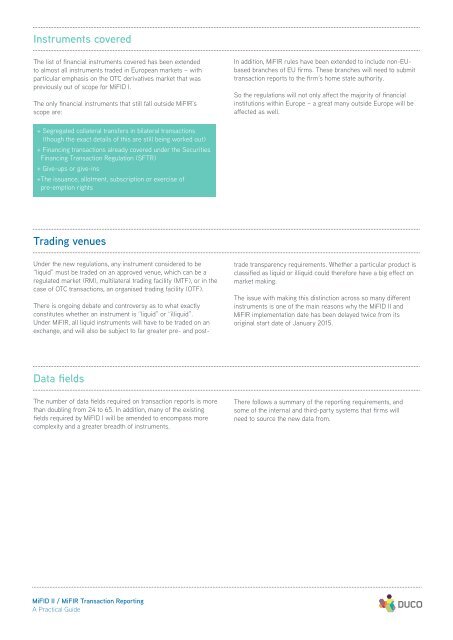MiFID II / MiFIR Transaction Reporting A Practical Guide
e5vYF-W
e5vYF-W
You also want an ePaper? Increase the reach of your titles
YUMPU automatically turns print PDFs into web optimized ePapers that Google loves.
Instruments covered<br />
The list of financial instruments covered has been extended<br />
to almost all instruments traded in European markets – with<br />
particular emphasis on the OTC derivatives market that was<br />
previously out of scope for <strong>MiFID</strong> I.<br />
The only financial instruments that still fall outside <strong>MiFIR</strong>’s<br />
scope are:<br />
In addition, <strong>MiFIR</strong> rules have been extended to include non-EUbased<br />
branches of EU firms. These branches will need to submit<br />
transaction reports to the firm’s home state authority.<br />
So the regulations will not only affect the majority of financial<br />
institutions within Europe – a great many outside Europe will be<br />
affected as well.<br />
+ Segregated collateral transfers in bilateral transactions<br />
(though the exact details of this are still being worked out)<br />
+Financing transactions already covered under the Securities<br />
Financing <strong>Transaction</strong> Regulation (SFTR)<br />
+ Give-ups or give-ins<br />
+The issuance, allotment, subscription or exercise of<br />
pre-emption rights<br />
Trading venues<br />
Under the new regulations, any instrument considered to be<br />
“liquid” must be traded on an approved venue, which can be a<br />
regulated market (RM), multilateral trading facility (MTF), or in the<br />
case of OTC transactions, an organised trading facility (OTF).<br />
There is ongoing debate and controversy as to what exactly<br />
constitutes whether an instrument is “liquid” or “illiquid”.<br />
Under <strong>MiFIR</strong>, all liquid instruments will have to be traded on an<br />
exchange, and will also be subject to far greater pre- and posttrade<br />
transparency requirements. Whether a particular product is<br />
classified as liquid or illiquid could therefore have a big effect on<br />
market making.<br />
The issue with making this distinction across so many different<br />
instruments is one of the main reasons why the <strong>MiFID</strong> <strong>II</strong> and<br />
<strong>MiFIR</strong> implementation date has been delayed twice from its<br />
original start date of January 2015.<br />
Data fields<br />
The number of data fields required on transaction reports is more<br />
than doubling from 24 to 65. In addition, many of the existing<br />
fields required by <strong>MiFID</strong> I will be amended to encompass more<br />
complexity and a greater breadth of instruments.<br />
There follows a summary of the reporting requirements, and<br />
some of the internal and third-party systems that firms will<br />
need to source the new data from.<br />
<strong>MiFID</strong> <strong>II</strong> / <strong>MiFIR</strong> <strong>Transaction</strong> <strong>Reporting</strong><br />
A <strong>Practical</strong> <strong>Guide</strong>


